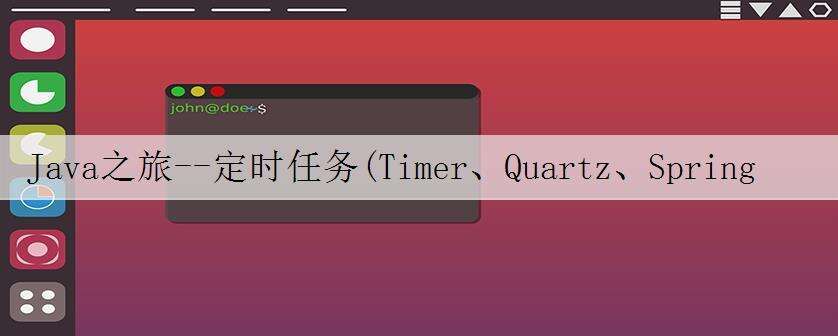Java之旅--定时任务(Timer、Quartz、Spring、LinuxCron)

在Java中,实现定时任务有多种方式,本文介绍4种,Timer和TimerTask、Spring、QuartZ、Linux Cron。
以上4种实现定时任务的方式,Timer是最简单的,不需要任何框架,仅仅JDK就可以,缺点是仅仅是个时间间隔的定时器,调度简单;Spring和QuartZ都支持cron,功能都很强大,Spring的优点是稍微简单一点,QuartZ的优点是没有Spring也可使用;Linux Cron是个操作系统级别的定时任务,适用于所有操作系统支持的语言,缺点是精度只能到达分钟级别。
Timer和TimerTask
关于Timer定时器的实现原理,如果我们看过JDK源码,就会发现,是使用的Object.wait(timeout),来进行的线程阻塞,timeout是根据下次执行实际和当前实际之差来计算。实际上,这可以归结为一个多线程协作(协作都是在互斥下的协作)问题。
在java.util.concurrent中,有个ScheduledThreadPoolExecutor,也可以完全实现定时任务的功能。
而其他的框架,无非是功能的增强,特性更多,更好用,都是在基础的java之上的包装。
代码示例如下:
import java.util.Date;
import java.util.Timer;
import java.util.TimerTask;
public class TimerTest extends TimerTask
{
private Timer timer;
public static void main(String[] args)
{
TimerTest timerTest= new TimerTest();
timerTest.timer = new Timer();
//立刻开始执行timerTest任务,只执行一次
timerTest.timer.schedule(timerTest,new Date());
//立刻开始执行timerTest任务,执行完本次任务后,隔2秒再执行一次
//timerTest.timer.schedule(timerTest,new Date(),2000);
//一秒钟后开始执行timerTest任务,只执行一次
//timerTest.timer.schedule(timerTest,1000);
//一秒钟后开始执行timerTest任务,执行完本次任务后,隔2秒再执行一次
//timerTest.timer.schedule(timerTest,1000,2000);
//立刻开始执行timerTest任务,每隔2秒执行一次
//timerTest.timer.scheduleAtFixedRate(timerTest,new Date(),2000);
//一秒钟后开始执行timerTest任务,每隔2秒执行一次
//timerTest.timer.scheduleAtFixedRate(timerTest,1000,2000);
try
{
Thread.sleep(10000);
} catch (InterruptedException e)
{
e.printStackTrace();
}
//结束任务执行,程序终止
timerTest.timer.cancel();
//结束任务执行,程序并不终止,因为线程是JVM级别的
//timerTest.cancel();
}
@Override
public void run()
{
System.out.println("Task is running!");
}
}
使用spring @Scheduled注解执行定时任务
这种方式非常简单,却能使用cron完成和QuartZ一样的功能,值得推荐一下。
ApplicationContext.xml:
beans根节点增加内容:xmlns:task="http://www.springframework.org/schema/task"
beans根节点中,xsi:schemaLocation属性下增加:
http://www.springframework.org/schema/taskhttp://www.springframework.org/schema/task/spring-task-3.1.xsd
task:annotation-driven/
实现类:
@Component //import org.springframework.stereotype.Component;
public class MyTestServiceImpl implements IMyTestService {
@Scheduled(cron="0/5 * * * * ? ") //每5秒执行一次
@Override
public void myTest(){
System.out.println("进入测试");
}
}
注意几点:
spring的@Scheduled注解 需要写在实现上;
定时器的任务方法不能有返回值;
实现类上要有组件的注解@Component,@Service,@Repository
QuartZ
QuartZ With Spring
applicationContext-schedule.xml
<?xml version="1.0" encoding="UTF-8"?>
<beans xmlns="http://www.springframework.org/schema/beans" xmlns:xsi="http://www.w3.org/2001/XMLSchema-instance"
xmlns:context="http://www.springframework.org/schema/context"
xsi:schemaLocation="http://www.springframework.org/schema/beans
http://www.springframework.org/schema/beans/spring-beans-2.5.xsd
http://www.springframework.org/schema/context http://www.springframework.org/schema/context/spring-context-2.5.xsd">
<bean id="quartzScheduler" class="org.springframework.scheduling.quartz.SchedulerFactoryBean">
<property name="triggers">
<list>
<!-- 启动的Trigger列表 -->
<ref local="startThriftTrigger" />
</list>
</property>
<property name="quartzProperties">
<props>
<prop key="org.quartz.threadPool.threadCount">5</prop>
</props>
</property>
<!-- 启动时延期3秒开始任务 -->
<property name="startupDelay" value="3" />
<property name="autoStartup" value="${scheduler.autoStartup}" />
</bean>
<!-- 启动Thrift,立即启动 -->
<bean id="startThriftTrigger" class="org.springframework.scheduling.quartz.SimpleTriggerBean">
<property name="startDelay" value="0" />
<property name="repeatInterval" value="1000" />
<property name="repeatCount" value="0" />
<property name="jobDetail" ref="startThriftTask" />
</bean>
<bean id="startThriftTask" class="org.springframework.scheduling.quartz.MethodInvokingJobDetailFactoryBean">
<property name="targetObject" ref="startThrift" />
<property name="targetMethod" value="execute" />
<!-- 同一任务在前一次执行未完成而Trigger时间又到时是否并发开始新的执行, 默认为true. -->
<property name="concurrent" value="true" />
</bean>
</beans>
实现类
package xx.schedule;
@Component
public class StartThrift {
/**
* 调度入口
*/
public void execute() {
// to do something
}
}
QuartZ No Spring
使用的QuartZ jar是1.8.5,如下:
<dependency>
<groupId>org.quartz-scheduler</groupId>
<artifactId>quartz</artifactId>
<version>1.8.5</version>
</dependency>
调用类实现代码如下:
import org.quartz.CronExpression;
import org.quartz.CronTrigger;
import org.quartz.JobDetail;
import org.quartz.Scheduler;
import org.quartz.SchedulerException;
import org.quartz.SchedulerFactory;
import org.quartz.impl.StdSchedulerFactory;
public class InvokeStatSchedule {
public void start() throws SchedulerException
{
SchedulerFactory schedulerFactory = new StdSchedulerFactory();
Scheduler scheduler = schedulerFactory.getScheduler();
//InvokeStatJob是实现了org.quartz.Job的类
JobDetail jobDetail = new JobDetail("jobDetail", "jobDetailGroup", InvokeStatJob.class);
CronTrigger cronTrigger = new CronTrigger("cronTrigger", "triggerGroup");
try {
CronExpression cexp = new CronExpression("0 0 * * * ?");
cronTrigger.setCronExpression(cexp);
} catch (Exception e) {
e.printStackTrace();
}
scheduler.scheduleJob(jobDetail, cronTrigger);
scheduler.start();
}
}
定时任务类代码如下:
import org.quartz.Job;
import org.quartz.JobExecutionContext;
import org.quartz.JobExecutionException;
public class InvokeStatJob implements Job {
@Override
public void execute(JobExecutionContext arg0) throws JobExecutionException {
//...要定时操作的内容
}
}
Linux Cron
这其实也是一种非常普遍的实现定时任务的方式,实际是操作系统的定时任务。Linux Cron只能到达分钟级,到不了秒级别。
一般我们是设置定时执行一个sh脚本,在脚本里面写一些控制代码,例如,有如下的脚本:
3,33 * * * * /usr/local/log_parser/run_log_parser.sh &
run_log_parser.sh的内容大致如下:
#!/bin/sh
log_parser_dir=/usr/local/log_parser
tmp_file=/usr/local/run_parser_tmp.txt
parser_log=/usr/local/access_parser.log
tmpDir=/data/applogs/access_logs_bp
date >> "$parser_log"
if [! -f "$tmp_file"]; then
echo '访问日志解析正在进行,尚未完成' >> "$parser_log"
echo '' >> "$parser_log"
else
echo '开始解析访问日志' >> "$parser_log"
touch "$tmp_file"
cd "$log_parser_dir"
python access_log_parser.py >> "$parser_log"
rm "$tmp_file"
echo '解析访问日志完成' >> "$parser_log"
echo '' >> "$parser_log"
cd "$tmpDir"
gzip gzip WEB0*
mv *.gz gz/
echo '压缩备份日志及移动到压缩目录成功' >> "$parser_log"
fi
from: https://www.kancloud.cn/digest/java-travel/159427